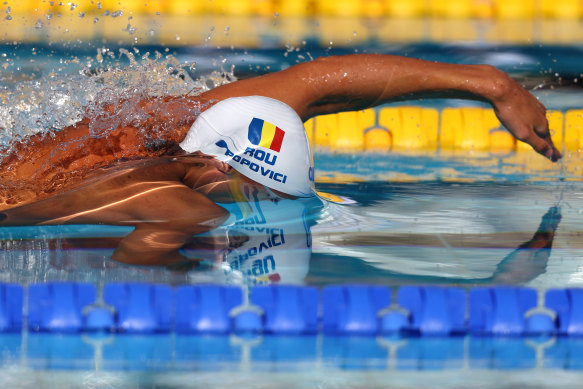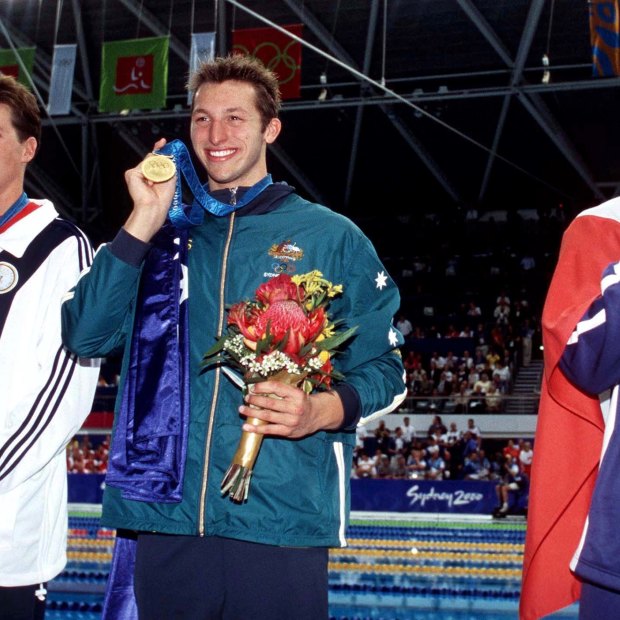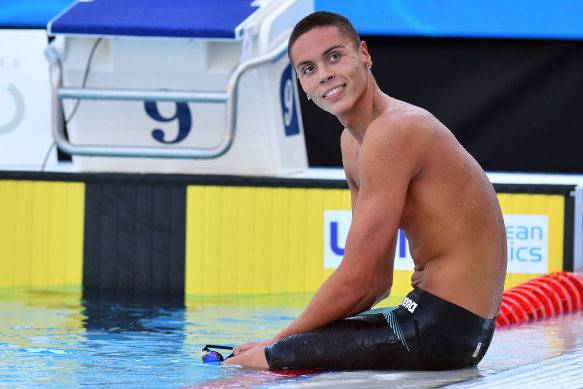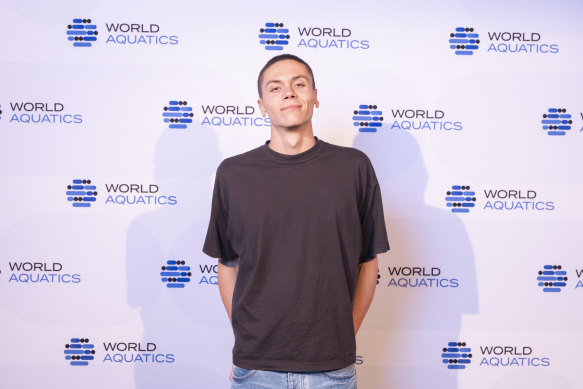Every elite swimmer dreams of winning an Olympic gold medal. The more ambitious ones set their sights higher, with world records firmly on their minds.
Then there are the ones who want to create a legacy, swimming times that those before them could never have imagined possible.
But David Popovici, swimming’s next superstar, wants more.
Much more.
Don’t be fooled by the Romanian’s fourth place this week in the 100m freestyle at the World Shortcourse Championships.
Shortcourse will never be Popovici’s thing. He might not even win his 200m freestyle event this weekend.
At the next Olympics though, he is the swimmer that everyone will want to know about.
Advertisement
In an interview with the Herald and The Age in Melbourne this week, Popovici sits cross-legged in a pair of baggy denim jeans.
He is asked the question that anyone with half a clue about swimming wants to know.
How fast can the newly crowned 100m and 200m freestyle world champion go?

David Popovici already holds the 100m freestyle world record but has his sights set on loftier goals.Credit:Getty
If there was ever a quote to send chills down the spines of rivals all over the world, including Australian Kyle Chalmers, here it is from the 18-year-old world record holder in the 100m freestyle.
“I don’t really want to say a number,” Popovici says. “But I do want to specify that we want to do the unthinkable and reach numbers and times people haven’t imagined are going to be touched in a hundred years from now.”
One hundred years. A once-in-a-century swimmer.
Advertisement
Let that sink in for a second.
It’s a bit like that Adidas slogan: Impossible is Nothing.
Popovici’s quote would not be uttered by an Australian swimmer in a hundred years.
Prodigious talents in this part of the world are notoriously reluctant to shoot for the stars — at least publicly — when crashing back to earth is a possibility.
The teenager who began swimming at a Bucharest pool at the age of four, to help correct early-stage scoliosis, is comfortable exuding confidence.
Often mentioned in the same sentence as Michael Phelps and Ian Thorpe, Popovici is articulate and methodical about his plan for world domination.
Advertisement
“It all comes down to how badly do you want it?” Popovici says. “It’s about how hard you’re willing to work and sacrifice. How much are you willing to shift your life for that one goal?”

Popovici began swimming aged four to assist with early-stage scoliosis.Credit:Getty
Thorpe nods approvingly when told of Popovici’s grandiose goals.
“I like that. There’s this beauty in being young. There isn’t any restriction on the way you think of what you can actually accomplish,” Thorpe says. “I like people who take chunks of time off world records. He’s becoming a big star in Romania.
“You’ll have a pioneer that will go out and break world records, achieve things when everyone said ‘that world record will never be broken’. Once you’ve been that person, everyone starts copying you. They copy your training program. You see the whole world catch up.
“When he gets to his peak of performance, it will then take years for people to catch up and be at his level again.”

Ian Thorpe after winning gold in the 400m freestyle at the Sydney 2000 Olympics.Credit:Getty
Advertisement
As a 17-year-old, Popovici sliced 0.05 seconds off Cesar Cielo’s world record that stood for 13 years in the 100m freestyle.
In the 200m freestyle, viewed as one of the most unachievable world records to surpass, Popovici is less than a second off Paul Biedermann’s magic mark of 1:42.00.
A little-known fact is that Thorpe can take some credit for Popovici’s maiden World Championship gold medal in Budapest this year. He was the first man to pull off the 100-200 freestyle quinella since Jim Montgomery in 1973.
“He was a bit of a fan,” Thorpe says. “I just said ‘if you win the 200 [freestyle] and you swim the race in a way that I like to see it, I’ll present you with your gold medal’. He then had an extra reason to do it. Then I was like ‘oh wow, I have to organise that’. I thought he was going to win.

David Popovici is the first man to win the 100m-200m freestyle world championship double in almost half a century.Credit:Getty
“It’s about not having any restrictions on what he can accomplish. That’s the big one. Even thinking you can take two tenths of a second off the world record is a limitation. Why not take off a second or more? It is possible. I’ve done it. He’s someone that could do it. There isn’t a limitation on him.”
Popovici was born exactly one month after Thorpe won swimming’s ‘race of the century’ — the 200m freestyle final at the 2004 Athens Olympics against Pieter van den Hoogenband, Grant Hackett and Michael Phelps.
Advertisement
“I only heard about Ian Thorpe when I was a little older,” Popovici says. “He inspired me. I watched his races. I was amazed, like everyone else, how he could float through the water and how well he swam. I’ve met him. He’s a cool and reserved guy.
“I’m glad that he got to put the medal around my neck when I won gold at the World Championships. I don’t want to be too annoying or be a fanboy.”
Thorpe and Popovici have similar techniques. The latter stands at 190cm but has a 205cm wingspan.
Thorpe is actually taller than his wingspan (by about three centimetres) but it was his size 17 feet that propelled him through the water.
Popovici wears size 14 skate shoes during his interview.

David Popovici stands 190cm tall and has a wingspan of 205cm.Credit:Getty
Fundamentally, swimming is all about minimum effort for maximum impact.
Popovici has outstanding buoyancy, meaning he is above the water more than competitors. His skinny frame glides through the water in a way swimming experts say is different to his competitors.
“We’re very different body shapes but I am very different to everyone else,” says Thorpe. “His body shape is more traditional to swimming. He’s not dissimilar to an Alexander Popov. He swims in a similar way to him. Pete van den Hoogenband was very lean too. I haven’t seen someone who looks like me swim, since me.”
Popovici has been working with his coach, Adrian Radulescu, since he was nine.
Loading
Radulescu has a PhD in athletic performance and has helped craft what will be the most scrutinised technique in swimming by the time the Paris Olympics begin in less than two years.
“The technique I have now is very specific,” Popovici said. “It started with my coach just accepting the way I swim naturally and enhancing that, not trying to correct me to how people thought sprinters should swim. It was really natural and we’re working on that. I’ve heard a lot of comparisons between my strokes and Ian Thorpe’s and Alexander Popov’s too.”
Popovici pauses.
“I can see the resemblance but I’m hoping to become even bigger than both of them,” he says.
This kid means business.
Sports news, results and expert commentary. Sign up for our Sport newsletter.